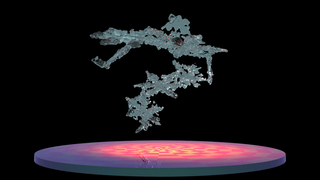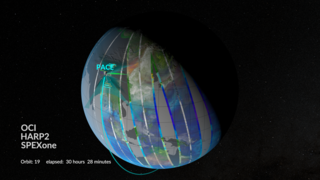Earth
ID: 4700
In terms of life on Earth, color describes more than simply how features look. In many cases color serves as a proxy for biological processes. When studying ocean biology, colors count in a big way.
NASA’s PACE mission (Plankton, Aerosol, Cloud, ocean Ecosystem) has been conceived principally as a way to measure ocean color for assessing large scale ocean health. These measurements will provide data to determine the distribution of phytoplankton, tiny plants and algae that sustain the marine food web. A simple way to think about this is the more “green” that’s visible from space, the more prevalent are plant cells containing chlorophyll, an essential green pigment responsible for energy-producing photosynthesis in plants. Phytoplankton populations are fundamental to understanding the overall health of the ocean food web, as well as a wide range of related processes.
PACE will be able to see other colors too—a broad range of color, in fact, stretching beyond the bounds of visible light into both ultraviolet as well as infrared. PACE will also be able to make measurements of aerosols in the atmosphere, essential for scientists to improve our understanding of and our ability to forecast weather and climate.
PACE continues a more than 20 year legacy of ocean color measurements, providing the scientific community with a long time series of data. That legacy enables better assessments of long term trends about complex processes on Earth.
PACE - Studying Plankton, Aerosols, Clouds, and the Ocean Ecosystem
There is a newer version of this story located here: https://svs.gsfc.nasa.gov/5019
NASA’s PACE mission (Plankton, Aerosol, Cloud, ocean Ecosystem) has been conceived principally as a way to measure ocean color for assessing large scale ocean health. These measurements will provide data to determine the distribution of phytoplankton, tiny plants and algae that sustain the marine food web. A simple way to think about this is the more “green” that’s visible from space, the more prevalent are plant cells containing chlorophyll, an essential green pigment responsible for energy-producing photosynthesis in plants. Phytoplankton populations are fundamental to understanding the overall health of the ocean food web, as well as a wide range of related processes.
PACE will be able to see other colors too—a broad range of color, in fact, stretching beyond the bounds of visible light into both ultraviolet as well as infrared. PACE will also be able to make measurements of aerosols in the atmosphere, essential for scientists to improve our understanding of and our ability to forecast weather and climate.
PACE continues a more than 20 year legacy of ocean color measurements, providing the scientific community with a long time series of data. That legacy enables better assessments of long term trends about complex processes on Earth.
Used Elsewhere In
Newer Version
Visualization Credits
Kel Elkins (USRA): Lead Visualizer
Alex Kekesi (Global Science and Technology, Inc.): Visualizer
Michael Starobin (KBR Wyle Services, LLC): Lead Producer
Jeremy Werdell (NASA/GSFC): Lead Scientist
Walt Feimer (KBR Wyle Services, LLC): Animator
Michael Lentz (USRA): Animator
Alex Kekesi (Global Science and Technology, Inc.): Visualizer
Michael Starobin (KBR Wyle Services, LLC): Lead Producer
Jeremy Werdell (NASA/GSFC): Lead Scientist
Walt Feimer (KBR Wyle Services, LLC): Animator
Michael Lentz (USRA): Animator
Please give credit for this item to:
NASA's Scientific Visualization Studio
NASA's Scientific Visualization Studio
Short URL to share this page:
https://svs.gsfc.nasa.gov/4700
Data Used:
Note: While we identify the data sets used in these visualizations, we do not store any further details nor the data sets themselves on our site.
Keywords:
DLESE >> Atmospheric science
DLESE >> Biology
GCMD >> Earth Science >> Biosphere
GCMD >> Earth Science >> Atmosphere >> Aerosols
GCMD >> Earth Science >> Atmosphere >> Clouds
SVS >> Hyperwall
NASA Science >> Earth
NASA Earth Science Focus Areas >> Carbon Cycle and Ecosystems
GCMD keywords can be found on the Internet with the following citation: Olsen, L.M., G. Major, K. Shein, J. Scialdone, S. Ritz, T. Stevens, M. Morahan, A. Aleman, R. Vogel, S. Leicester, H. Weir, M. Meaux, S. Grebas, C.Solomon, M. Holland, T. Northcutt, R. A. Restrepo, R. Bilodeau, 2013. NASA/Global Change Master Directory (GCMD) Earth Science Keywords. Version 8.0.0.0.0
https://svs.gsfc.nasa.gov/4700
Data Used:
SeaStar/SeaWiFS/Chlorophyll Concentration
1997/09 - 2007/11
All SeaWiFS images and data presented on this web site are for research and educational use only. All commercial use of SeaWiFS data must be coordinated with GeoEye.
Credit:
NASA/Goddard Space Flight Center, The SeaWiFS Project and GeoEye, Scientific Visualization Studio. NOTE: All SeaWiFS images and data presented on this web site are for research and educational use only. All commercial use of SeaWiFS data must be coordinated with GeoEye (NOTE: In January 2013, DigitalGlobe and GeoEye combined to become one DigitalGlobe.).
NASA/Goddard Space Flight Center, The SeaWiFS Project and GeoEye, Scientific Visualization Studio. NOTE: All SeaWiFS images and data presented on this web site are for research and educational use only. All commercial use of SeaWiFS data must be coordinated with GeoEye (NOTE: In January 2013, DigitalGlobe and GeoEye combined to become one DigitalGlobe.).
Comiso's Daily Sea Ice Concentration
Data Compilation - NASA/GSFC - 1997/9 - 2017/9SeaStar/SeaWiFS/NDVI
1997/09 - 2007/11
All SeaWiFS images and data presented on this web site are for research and educational use only. All commercial use of SeaWiFS data must be coordinated with GeoEye.
Credit:
NASA/Goddard Space Flight Center, The SeaWiFS Project and GeoEye, Scientific Visualization Studio. NOTE: All SeaWiFS images and data presented on this web site are for research and educational use only. All commercial use of SeaWiFS data must be coordinated with GeoEye (NOTE: In January 2013, DigitalGlobe and GeoEye combined to become one DigitalGlobe.).
NASA/Goddard Space Flight Center, The SeaWiFS Project and GeoEye, Scientific Visualization Studio. NOTE: All SeaWiFS images and data presented on this web site are for research and educational use only. All commercial use of SeaWiFS data must be coordinated with GeoEye (NOTE: In January 2013, DigitalGlobe and GeoEye combined to become one DigitalGlobe.).
Terra and Aqua/MODIS/Normalized Difference Vegetation Index (NDVI) also referred to as: NDVI
NASA - 2007/10 - 2012/2GEOS Atmospheric Model
Model - NASA GMAO - 2014/12Suomi NPP/VIIRS also referred to as: VIIRS
2018/08Interactive Multisensor Snow and Ice Mapping System (IMS)/IMS Daily Northern Hemisphere Snow and Ice Analysis - 24 km Resolution also referred to as: IMS Daily Northern Hemisphere Snow and Ice Analysis
Analysis - NOAA - 1997/9 - 2017/9Aqua/MODIS/Chlorophyll Concentration OCl also referred to as: chlor_a
2007/10 - 2012/2
Credit:
Ocean Biology Processing Group (OBPG)
Ocean Biology Processing Group (OBPG)
Suomi NPP/VIIRS/Chlorophyll Concentration also referred to as: Chlorophyll
Observed Data - 2012/2 - 2017/9Suomi NPP/VIIRS/NDVI also referred to as: Normalized Difference Vegetation Index
Analysis - 2012/2 - 2017/9Keywords:
DLESE >> Atmospheric science
DLESE >> Biology
GCMD >> Earth Science >> Biosphere
GCMD >> Earth Science >> Atmosphere >> Aerosols
GCMD >> Earth Science >> Atmosphere >> Clouds
SVS >> Hyperwall
NASA Science >> Earth
NASA Earth Science Focus Areas >> Carbon Cycle and Ecosystems
GCMD keywords can be found on the Internet with the following citation: Olsen, L.M., G. Major, K. Shein, J. Scialdone, S. Ritz, T. Stevens, M. Morahan, A. Aleman, R. Vogel, S. Leicester, H. Weir, M. Meaux, S. Grebas, C.Solomon, M. Holland, T. Northcutt, R. A. Restrepo, R. Bilodeau, 2013. NASA/Global Change Master Directory (GCMD) Earth Science Keywords. Version 8.0.0.0.0













